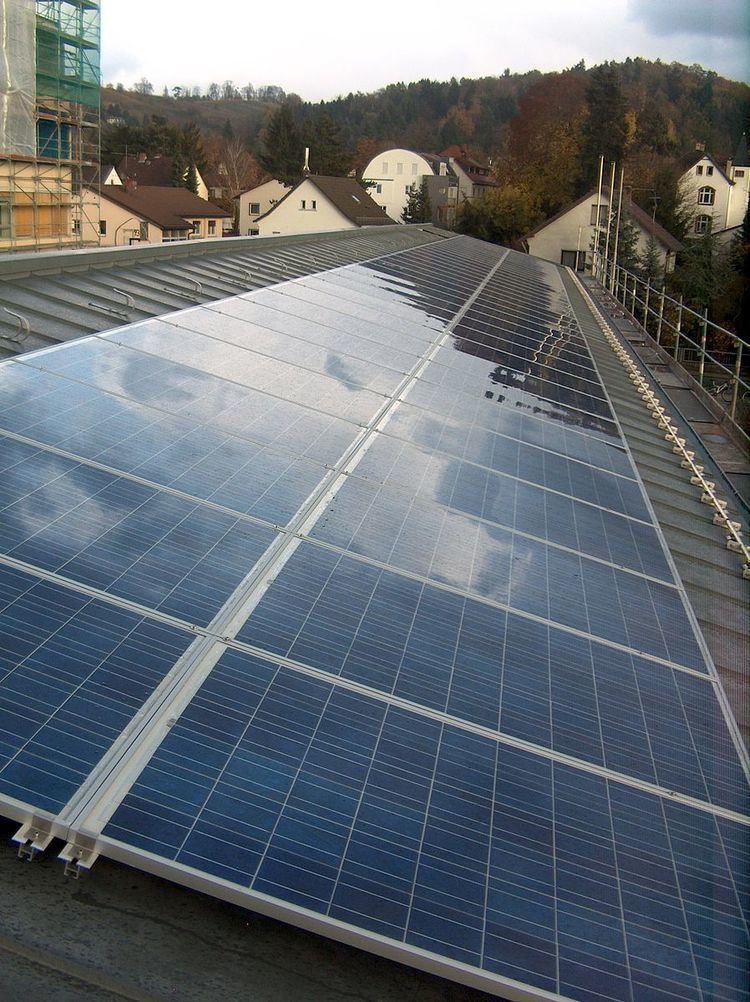 | ||
A rooftop photovoltaic power station, or rooftop PV system, is a photovoltaic system that has its electricity-generating solar panels mounted on the rooftop of a residential or commercial building or structure. The various components of such a system include photovoltaic modules, mounting systems, cables, solar inverters and other electrical accessories.
Contents
- Installation
- Feed in tariff mechanism
- Hybrid systems
- Advantages
- Disadvantages
- Technical Challenges
- Future prospects
- References
Rooftop mounted systems are small compared to ground-mounted photovoltaic power stations with capacities in the megawatt range. Rooftop PV systems on residential buildings typically feature a capacity of about 5 to 20 kilowatts (kW), while those mounted on commercial buildings often reach 100 kilowatts or more.
Installation
The urban environment provides a large amount of empty rooftop spaces and can inherently avoid the potential land use and environmental concerns. Estimating rooftop solar insolation is a multi-faceted process, as insolation values in rooftops are impacted by the following:
There are various methods for calculating potential solar PV roof systems including the use of Lidar and orthophotos. Sophisticated models can even determine shading losses over large areas for PV deployment at the municipal level.
Feed-in tariff mechanism
In a grid connected rooftop photovoltaic power station, the generated electricity can sometimes be sold to the servicing electric utility for use elsewhere in the grid. This arrangement provides payback for the investment of the installer. Many consumers from across the world are switching to this mechanism owing to the revenue yielded. A public utility commission usually sets the rate that the utility pays for this electricity, which could be at the retail rate or the lower wholesale rate, greatly affecting solar power payback and installation demand.
The FIT as it is commonly known has led to an expansion in the solar PV industry worldwide. Thousands of jobs have been created through this form of subsidy. However it can produce a bubble effect which can burst when the FIT is removed. It has also increased the ability for localised production and embedded generation reducing transmission losses through power lines.
Hybrid systems
A rooftop photovoltaic power station (either on-grid or off-grid) can be used in conjunction with other power sources like diesel generators, wind turbine etc. This system is capable of providing a continuous source of power.
Advantages
Installers have the right to feed solar electricity into the public grid and hence receive a reasonable premium tariff per generated kWh reflecting the benefits of solar electricity to compensate for the current extra costs of PV electricity.
Disadvantages
An electrical power system containing a 10% contribution from PV stations would require a 2.5% increase in load frequency control (LFC) capacity over a conventional system. The break-even cost for PV power generation is found to be relatively high for contribution levels of less than 10%. Higher proportions of PV power generation gives lower break-even costs, but economic and LFC considerations imposed an upper limit of about 10% on PV contributions to the overall power systems.
Technical Challenges
There are many technical challenges to integrating large amounts of rooftop PV systems to the power grid. For example:
Future prospects
The Jawaharlal Nehru National Solar Mission of the Indian government is planning to install utility scale grid-connected solar photovoltaic systems including rooftop photovoltaic systems with the combined capacity of up to 100 gigawatts by 2022.
